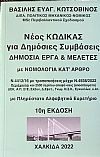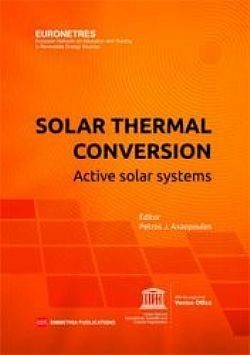ΚΑΤΗΓΟΡΙΕΣ
NEWSLETTER
Συπληρώστε το email σας
για να λάβετε τις προσφορές
και τα νέα της Bookstation
ΝΕΟΙ ΤΙΤΛΟΙ
-
Νέος Κώδικας για Δημόσιες Συμβάσεις ... -10η έκδοση-ΔΩΡΕΑΝ ΤΑ ΕΞΟΔΑ ΑΠΟΣΤΟΛΗΣ
Κωτσοβίνος Ευαγ. Βασίλης προσθήκη στο καλάθι
προσθήκη στο καλάθι
ISBN 978-618-845-981-6
Τιμή | 54 € -
Οι κωδικοί του Ε9 (Δήλωση Ακινήτων)-2024 -ΑΜΕΣΑ ΔΙΑΘΕΣΙΜΟ
Ορέστης Εμμ. Σεϊμένης-Μανούσος Ιωάν. Ντουκάκης προσθήκη στο καλάθι
προσθήκη στο καλάθι
ISBN 978-618-87035-0-6
Τιμή | 54 € -
Νέος φορολογικός οδηγός -φορολογικές δηλώσεις 2024 -Φυσικών και νομικών πτοσώπων
Στεργίου Ιωάννης προσθήκη στο καλάθι
προσθήκη στο καλάθι
ISBN 978-618-5678-61-6
Τιμή | 76.5 €
περισσότερα >
Κατηγορίες / . / Έλληνες Εκδότες / Εκδόσεις Συμμετρία / SOLAR THERMAL CONVERSION active solar systems

SOLAR THERMAL CONVERSION active solar systems
Petros J. Axaopoulos
Εκδόσεις
Συμμετρία
ISBN: 978-960-266-328-8
Σελίδες: 548
Σχήμα: 17Χ24
Εξώφυλλο: Χαρτόδετο
Ημερομηνία έκδοσης: Ενημέρωση 05/2015
Τιμή | 40.07 €
ΠΕΡΙΕΧΟΜΕΝΑ-CONTENTS: Preface 1. Introduction Petros J. Axaopoulos Bibliography 2. The sun and its radiation Petros J. Axaopoulos 2.1 The sun 2.2 Extraterrestrial solar radiation and atmospheric effects 2.3 Components of solar radiation 2.4 European distribution of solar irradiation 2.5 The measurement of solar radiation 2.5.1 Pyranometer 2.5.2 Pyrheliometer 2.5.3 Sunshine recorder References Additional reading 3. Basic principles of solar geometry Petros J. Axaopoulos 3.1 The earth?s rotation 3.2 Longitude and latitude 3.3 Basic solar geometry angles 3.3.1 Determination of solar angles 3.4 Solar incidence angle 3.5 Solar time References Additional reading 4. Heat transfer topics Milorad Bojic 4.1 Conduction 4.2 Convection 4.3 Radiation 4.4 Combined heat - transfer 4.5 Heat exchangers References 5. Solar radiation incident on horizontal and tilted surfaces at ground level Viorel Badescu 5.1 Model accuracy 5.2 Solar radiation on horizontal surfaces at ground level 5.2.1 Models to evaluate solar irradiance values on clear sky days 5.2.1.1 Very simple clear sky solar irradiance models 5.2.1.2 Simple clear sky solar irradiance models 5.2.2 Computation of hourly average solar irradiance 5.2.2.1 Very simple cloudy sky models to compute hourly average solar irradiance 5.2.2.2 Simple cloudy sky models to compute hourly average solar irradiance 5.2.3 Computation of daily average solar irradiation 5.2.3.1 Computation by integration from solar irradiance data 5.2.3.2 Relationships to evaluate daily diffuse and beam irradiation 5.2.4 Models to evaluate monthly averaged irradiation values 5.2.4.1 Relationships for global irradiation based on sunshine data 5.2.4.2 Relationships for global irradiation based on point cloudiness data 5.2.4.3 Relationships for diffuse and beam irradiation 5.3 Solar radiation on arbitrary tilted and oriented surfaces 5.3.1 Solar irradiances on tilted surfaces 5.3.2 Daily solar irradiation on tilted surfaces 5.3.2.1 Daily optimum tilt and orientation angles 5.3.3 Monthly averages of daily solar irradiation on tilted surfaces 5.3.3.1 Monthly and seasonal optimum tilt and orientain angles 5.4 Recommendations about computing solar radiation on horizontal and tilted surfaces References Glossary 6. Optical characteristics of materials Marius Paulescu and Paul Gravila Introduction 6.1 Optics summary 6.1.1 Reflectance ? transmittance ? absorptance 6.1.2 Transmittance ? absorptance product 6.1.3 Total emitance, absorptance and transmittance 6.2 Transparent cover plate materials 6.3 Opaque collector plate surfaces Summary References 7. Solar collectors Soteris A. Kalogirou 7.1 Flat plate collectors (FPC) 7.1.1 Flat - plate collector components 7.1.1.1 Cover plate 7.1.1.2 Collector absorbing plates 7.1.2 Liquid heating flat - plate collectors 7.1.3 Air heating flat - plate collectors 7.1.4 Thermal analysis for a flat - plate collector 7.1.4.1 Collector efficiency factor 7.1.5 Collector efficiency 7.1.5.1 Collector incidence angle modifier 7.1.5.2 Collector time constant Contents 7 7.1.6 Collector performance and quality testing 7.1.7 Factors affecting the solar collector efficiency 7.2 Evacuated tube collectors (ETC) 7.3 Concentrating collectors 7.3.1 Compound parabolic collectors (CPC) 7.3.2 High concentration collectors 7.3.2.1 Parabolic trough collectors 7.3.2.2 Linear fresnel reflector (LFR) 7.3.2.3 Parabolic dish reflector (PDR) 7.3.2.4 Heliostat field collector (HFC) References Further reading Glossary 8. Thermal energy storage Panayotis T. Tsilingiris 8.1 Introduction 8.2 The specific heat capacity of substances 8.3 The technology of sensible heat storage 8.4 The analysis of the water heat storage 8.4.1 The well mixed storage 8.4.2 The influence of thermal stratification 8.5 The analysis of heat storage in packed bed solid materials 8.6 The heat storage in building elements and structures . 8.6.1 Human comfort and thermal storage 8.6.2 Heat storage in passive building design 8.6.3 The heat strorage in structural elements and the building envelope 8.6.4 The combined influence of thermal resistance and heat capacity in building elements 8.7 Long term seasonal storage 8.7.1 Limiting dimensions of seasonal heat storage systems and examples 8.8 Solar ponds 8.8.1 The fundamental system description and operation 8.8.2 Modeling of the physical processes 8.8.3 Stability and zone boundary migration considerations 8.8.4 The potential of solar ponds as large low - grade heat storage systems 8.9 Latent heat storage 8.9.1 The characteristics of candidate phase - change materials 261 References 9. Solar thermal systems Soteris A. Kalogirou 9.1 Domestic hot water 9.1.1 Thermosiphon systems 9.1.2 Direct circulation systems (active) 9.1.3 Indirect water heating systems (active) 9.1.4 Air systems for hot water production (active) 9.2 Solar space heating and cooling 9.2.1 Air systems 9.2.2 Water systems 9.2.3 Heat pump systems 9.2.4 Energy saving and environmental considerations 9.2.4.1 Application 9.3 Guaranteed solar results 9.3.1 The framework of guarantee References Further reading Glossary Abbreviations 10. Active solar heating systems design Yannis G. Caouris Introduction 10.1 Preliminary analysis 10.2 Feasibility study 10.3 Detailed design 10.3.1 System schematic 10.3.2 Collector subsystem 10.3.2.1 Array design 10.3.2.2 Piping design 10.3.2.3 Component requirements 10.3.3 Storage subsystem 10.3.4 Control subsystem References Contents 9 11. Industrial production of flat plate liquid solar collectors Yannis G. Caouris 11.1 The solar absorber 11.1.1 Stamped absorbers 11.1.2 Tube absorber 11.1.3 Roll bond absorbers 11.1.4 Organic absorbers 11.2 Check for leakages and cleaning of metal absorbers 11.3 Painting 11.4 Enclosure insulation and glazing References 12. Solar energy economics John J. Gelegenis Introduction . 12.1 Economic analysis 12.1.1 General 12.1.2 Simplified economic indicators 12.1.3 Discounted cash flows 12.2 Life cycle analysis 12.2.1 Net present value of the investment ? Life cycle solar savings 12.2.2 Discounted payback time 12.2.3 Internal rate of return 12.2.4 Other economic indexes 12.2.5 Factors affecting solar system appraisal 12.2.5.1 Loans 12.2.5.2 Taxation 12.2.5.3 Grants 12.2.5.4 Variation of energy prices 12.2.5.5 Inflation 12.3 Economic optimization 12.3.1 Maximization of life cycle savings 12.3.2 Consideration of uncertainties Summary Nomenclature Indexes Unsolved problems References 13. Software for active solar heating Panayiotis Yianoulis and Myrsini Giannouli 13.1 General considerations 13.2 Design of active solar systems 13.3 Solar radiation data 13.4 Comments on insolation data and models 13.5 Simulation of an active solar system 13.6 The TRNSYS (TRaNsient SYstems Simulation program) 13.6.1 General . 13.6.2 Standard components in TRNSYS 13.6.3 Updates and new features for TRNSYS 16 13.6.4 Components (fos Sale and Free Downloadable) 13.7 f - chart computer program 13.7.1 Program overview 13.7.2 Dimensionless variables {X, Y} 13.7.3 Applications in various configurations 13.7.4 Other considerations 13.8 Programs for the design of active systems by utilizability References 14. Solar thermal applications Panayotis T. Tsilingiris 14.1 Swimming pool heating 14.1.1 Heat balance and heat losses 14.1.2 Heat loss control and solar collectors 14.2 Agricultural drying 14.2.1 Crop drying and solar energy 14.2.2 The physical processes in drying 14.2.3 The design of solar driers 14.2.4 The use of desiccants in solar drying 14.3 Solar cooking 14.4 Solar desalination 14.4.1 Fundamental physical processes and taxonomy 14.4.2 The direct solar distillation systems 14.4.2.1 The heat balance in solar stills 14.4.2.2 The combined heat and mass transfer processes in solar distillation systems 14.4.2.3 Solar still design improvements 14.4.3 Indirect solar distillation systems Contents 11 14.5 Solar powered heat engines 14.5.1 Fundamental principles and thermodynamic limitations 14.5.2 The solar to mechanical energy conversion 14.5.3 The thermodynamic cycles 14.5.4 The stirling engines 14.5.5 Rankine power cycles 14.6 Solar thermal electric power systems 14.6.1 Parabolic trough solar collector field technology 14.6.2 Combined cycle systems 14.6.3 Central tower systems 14.6.4 Parabolic dish systems 14.6.5 Solar pond power plants 14.6.6 Comparative unit energy cost estimates 14.7 Solar assisted heat pump system 14.8 Solar absorption and adsorption systems 14.8.1 Absorption solar cooling systems 14.8.2 Solar dessicant cooling systems Referen.
ΑΝΑΖΗΤΗΣΗ
Σε όλες τις κατηγορίες
ΑΝΑΚΟΙΝΩΣΕΙΣ
5/9/2012 2:16:56 PM
περισσότερα >
BEST SELLERS
-
Λατινικά ...για 20! (για τη Γ' Λυκείου)
Χρήστος Ζηκούλης προσθήκη στο καλάθι
προσθήκη στο καλάθι
ISBN 978-618-5837-00-6
Τιμή | 50 € -
Λατινικά...για 20! (Για τη Β' λυκείου)
Χρήστος Ζηκούλης προσθήκη στο καλάθι
προσθήκη στο καλάθι
ISBN 978-618-86835-9-4
Τιμή | 25 € -
Μάθε το επάγγελμα που σου ταιριάζει (2024)
Χρήστος Αθ. Ζηκούλης προσθήκη στο καλάθι
προσθήκη στο καλάθι
ISBN 978-618-86835-4-9
Τιμή | 30 € -
Ανακάλυψε τη σχολή που σου αξίζει (2024)
Ζηκούλης, Χρήστος Αθ. προσθήκη στο καλάθι
προσθήκη στο καλάθι
ISBN
Τιμή |40,0036,00 € -
Ανακάλυψε τη σχολή που σου αξίζει (2024)
Ζηκούλης, Χρήστος Αθ. προσθήκη στο καλάθι
προσθήκη στο καλάθι
ISBN
Τιμή |50,0045,00 € -
Ανακάλυψε τη σχολή που σου αξίζει (2024)
Ζηκούλης, Χρήστος Αθ. προσθήκη στο καλάθι
προσθήκη στο καλάθι
ISBN
Τιμή |35,0031,50 €
περισσότερα >

